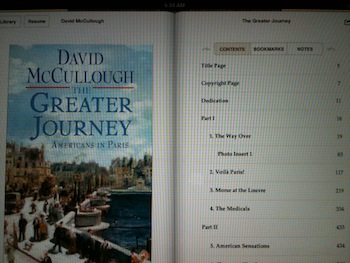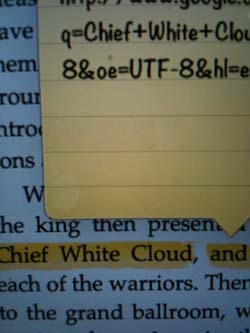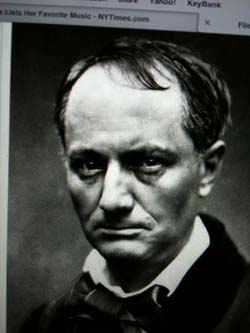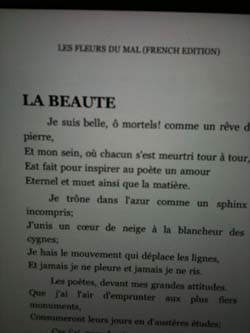
fno.org
|
|
| Vol 21|No 3|January 2012 | |
| Please feel free to e-mail this article to a friend, a principal, a parent, a colleague, a teacher librarian, a college professor, a poet, a magician, a vendor, an artist, a juggler, a student, a news reporter or to anyone else you think might enjoy it. | |
eReading:
|
|
 |
|
|
Reading on a smart phone, a laptop or an iPad type device - What's up? It seems we have reached a tipping point in publishing and reading. For certain tasks eBooks offer dramatic advantages over printed books. As suggested by Alan Reid in his FNO article, "Knowtation: Reading and Thinking Between the Lines and Around the Edges," eBooks support reading behaviors that are akin to but superior to the marginalia possible with printed books:
Reid predicts that eBooks will enhance the reading comprehension of students by facilitaing the knowtation mentioned above and taking it well beyond what is possible with paper books. The Value of Teachers Exploring eBooks To appreciate the added value of eBooks, teachers will need to incorporate this type of reading into their own lives. It may take reading a half dozen books of different kinds to grasp the benefits. Reading nonfiction, for example, may be enhanced more by the online resources accessible through an eBook than when reading a novel. As teachers read and explore, it might help to think of reading now as a conversation with the book — more interactive than it has been in the past. The list below provides examples of how this dialogue might proceed. Tasks for readers . . .
Enrichment Through Purposeful Wandering As one reads electronically, anything unfamiliar can become familiar as long as the reader is online at the time.
iBooks allows the reader to highlight the name of a person or place and do a search within the book, out on the Web or at Wikipedia. Forty years ago, the reader would have to get up and find their personal copy of the Deerslayer (if they had one) or drive to the local library to see a picture of Cooper on the dust jacket. Or maybe, if they were fortunate, they owned an encyclopedia that would have an article about Cooper. But the physical work required to find that article was much greater than what is required with iBooks or the Kindle software.
My curiosity awakened by his story, I went in search of his collection "Les Fleurs du Mal" which is available electronically in French from Amazon to read with Kindle software. I came to understand that this was a kind of reading far and wide that I had not often done in the past. In the past, print books have been somewhat sparing when it came to photographs, paintings and illustrations because the production costs could skyrocket, but digital books will have less trouble with these issues when they are created from scratch for the digital platform. At this point, most digital books have been shifted over from print without any attempt to design the eBook so as to exploit the benefits of connectedness. Later in the book, I came across a collection of wonderful images, many of which were the same as the ones I had sought out while reading. Following a typical printed book convention, these images were all grouped together in a special section — dictated probably by cost considerations — rather than placed next to the pertinent text. Comparing Non-Fiction, Fiction and Poetry In a future article, I will take a look at how reading might differ for each of these types of reading. At this point I am seeing the greatest pay-off for reading non-fiction, but time will tell. A related question might be how eBooks should differ from print books in their format. So many eBooks are really just digitized paper books that make no special effort to exploit the advantages of hyper-text and online resources. What should authors and book designers be integrating into their eBooks that would distinguish them from printed books? What functions make them superior?
|
|
|
Copyright Policy: Materials published in From Now On may be duplicated in hard copy format if unchanged in format and content for educational, nonprofit school district and university use only and may also be sent from person to person by e-mail. This copyright statement must be included. All other uses, transmissions and duplications are prohibited unless permission is granted expressly. Showing these pages remotely through frames is not permitted. |


 In reading about Americans in Paris in the 1830s, David McCullough's The Greater Journey, I found myself looking up the important figures he was describing in his book. I had read James Fenimore Cooper's Deerslayer as a boy but had no visual memory of his face.
In reading about Americans in Paris in the 1830s, David McCullough's The Greater Journey, I found myself looking up the important figures he was describing in his book. I had read James Fenimore Cooper's Deerslayer as a boy but had no visual memory of his face. I found the habit growing as I moved through the book. What began as an occasional diversion prompted by curiosity became a habit of mind and a concerted reading strategy. I came to appreciate how much richer the reading experience had become by supplementing McCullough's wonderful
I found the habit growing as I moved through the book. What began as an occasional diversion prompted by curiosity became a habit of mind and a concerted reading strategy. I came to appreciate how much richer the reading experience had become by supplementing McCullough's wonderful  text with dozens of visual images and additional background reading. At one point he mentions the big splash created by George Catlin's paintings of Native Americans and one painting in particular — a portrait of White Cloud. With a paper version of this book, I would not have turned to the Web so rapidly as I did with the iBooks version, though now that I see the value of such reading excursions, I will probably stretch the habit back over to reading a paper book, keeping my laptop or iPad close at hand.
text with dozens of visual images and additional background reading. At one point he mentions the big splash created by George Catlin's paintings of Native Americans and one painting in particular — a portrait of White Cloud. With a paper version of this book, I would not have turned to the Web so rapidly as I did with the iBooks version, though now that I see the value of such reading excursions, I will probably stretch the habit back over to reading a paper book, keeping my laptop or iPad close at hand. When McCullough mentions Baudelaire's positive reaction to Catlin's paintings, I realized I had heard of Baudelaire for years but knew little about him and could not remember reading any of his poems. When I highlighted his name and searched for him, I found a rather disturbing photograph of him and did some quick reading about his life. He was quite an amazing fellow, but his life was plagued by illness, drugs and money problems as well as what some called his "indolent ways."
When McCullough mentions Baudelaire's positive reaction to Catlin's paintings, I realized I had heard of Baudelaire for years but knew little about him and could not remember reading any of his poems. When I highlighted his name and searched for him, I found a rather disturbing photograph of him and did some quick reading about his life. He was quite an amazing fellow, but his life was plagued by illness, drugs and money problems as well as what some called his "indolent ways."  In a matter of minutes I was reading his poetry on my iPad and learned that I could download a free French dictionary that supplied me with French definitions of words that
In a matter of minutes I was reading his poetry on my iPad and learned that I could download a free French dictionary that supplied me with French definitions of words that  were unfamiliar to me. This all seemed magical to me.
were unfamiliar to me. This all seemed magical to me.